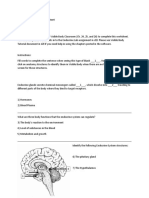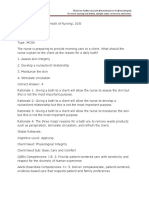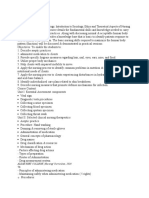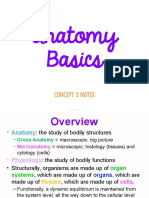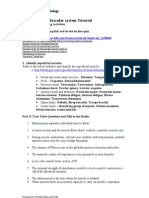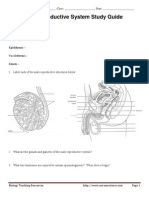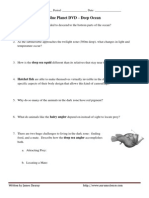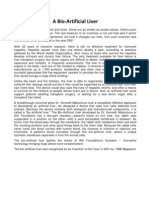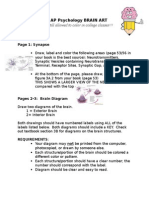Anatomy For Beginners - Movement Worksheet
Anatomy For Beginners - Movement Worksheet
Uploaded by
James DaurayCopyright:
Available Formats
Anatomy For Beginners - Movement Worksheet
Anatomy For Beginners - Movement Worksheet
Uploaded by
James DaurayOriginal Title
Copyright
Available Formats
Share this document
Did you find this document useful?
Is this content inappropriate?
Copyright:
Available Formats
Anatomy For Beginners - Movement Worksheet
Anatomy For Beginners - Movement Worksheet
Uploaded by
James DaurayCopyright:
Available Formats
Name: _____________________________________ Class: ________________ Date: ____________
Anatomy For Beginners
Lesson 1: Movement
1. List three functions of skin, the largest organ in the human body.
2. Only a tiny layer of skin (1/10th of a millimeter) is growing. What is the rest made of?
3. Describe how the shape of muscles varies between the abdominal area and the extremities.
4. What happens to the length of the muscle as the model flexes his bicep?
5. Anatomists used to believe muscles were like springs. Describe what actually occurs inside the muscle itself as it contracts.
6. Tendons connect _____________ to _____________.
7. Each joint has a pair of opposing muscles. In the example of the forearm, wrist, and hand, what movement does the flexor muscles produce? The extensors?
8. What is the largest muscle in the human body?
9. Why are the bones and muscles of the legs so much larger than the upper extremities?
Science Education Resources | http://www.aurumscience.com
Name: _____________________________________ Class: ________________ Date: ____________ 10. Label the trabeculae in the opened femur below. What is the purpose of the trabeculae?
11. Ligaments connect ____________ to _____________. 12. Explain how cartilage minimizes friction at a joint between two bones.
13. What is osteoarthritis?
14. The patella is a sesamoid bone. What is unusual about the location of bones like this?
15. Label the patellar tendon, cruciate ligaments (2), and meniscus on the knee diagram below.
Science Education Resources | http://www.aurumscience.com
Name: _____________________________________ Class: ________________ Date: ____________ 16. Why is it so difficult for Dr. von Hagans to move the lower leg by himself?
17. Brain is described as having the same consistency as Fromage frais. What happens when it is dropped?
18. Label the cell bodies, dendrites, and axons in the brain tissue slide below.
19. What function is each of these regions of the brain associated with? a. Side b. Back c. Front d. Cerebellum e. Stem 20. Identify the cortex (grey matter), the medulla (white matter), and the corpus callosum on the slice of brain.
Science Education Resources | http://www.aurumscience.com
Name: _____________________________________ Class: ________________ Date: ____________ 21. What is contained within the cortex? What is in the medulla?
22. Is the spinal cord considered part of the central or peripheral nervous system?
23. What happens if the spinal cord is cut?
24. Where does the spinal cord end?
25. What side of the spinal column do the motor fibers exit? The sensory fibers?
26. Peripheral nerves are described as mixed. Explain what this means.
Questions
27. How long does it take for brain tissue to begin to die following the loss of blood?
28. What causes the pins and needles sensation when a foot or hand falls asleep?
29. What happens differently to cause a quadriplegic versus a paraplegic?
Science Education Resources | http://www.aurumscience.com
You might also like
- Bio 137 Lab ManualDocument185 pagesBio 137 Lab ManualReedNo ratings yet
- Pharmacology Test 1: Questions and RationalesDocument52 pagesPharmacology Test 1: Questions and RationalesElla ReyesNo ratings yet
- 24 Hour Urine CollectionDocument11 pages24 Hour Urine CollectionKRIZIA ANE A. SULONGNo ratings yet
- Anatomy and Physiology Exam 2 NotesDocument5 pagesAnatomy and Physiology Exam 2 NotesMissy Sanders100% (1)
- Clinical Evaluation Tools Ver 2 First PageDocument3 pagesClinical Evaluation Tools Ver 2 First Pageapi-3697326No ratings yet
- Answers - MuscularSystemWebquestDocument7 pagesAnswers - MuscularSystemWebquestJxcari50% (2)
- Molecular Models of Covalent Compounds WorksheetDocument2 pagesMolecular Models of Covalent Compounds WorksheetJames Dauray100% (1)
- Proofed - Nurs 3020 Final EvaluationDocument9 pagesProofed - Nurs 3020 Final Evaluationapi-313199824No ratings yet
- Anatomy For Beginners - Reproduction WorksheetDocument4 pagesAnatomy For Beginners - Reproduction WorksheetJames Dauray100% (1)
- Objectives May Be Used To Support Student Reflection, Although The List of Indicators Is NotDocument14 pagesObjectives May Be Used To Support Student Reflection, Although The List of Indicators Is Notapi-456466614No ratings yet
- Ashleigh Cole Canadian Ota Pta Fieldwork Evaluation Form - Durham College 2016-2017Document14 pagesAshleigh Cole Canadian Ota Pta Fieldwork Evaluation Form - Durham College 2016-2017api-395143739No ratings yet
- Sorrentino: Mosby's Canadian Textbook For The Support Worker, 4th EditionDocument4 pagesSorrentino: Mosby's Canadian Textbook For The Support Worker, 4th EditionConor McLeodNo ratings yet
- Q&A Health Promotion MaintenanceDocument10 pagesQ&A Health Promotion Maintenanceapi-3818438100% (1)
- Chapter 028Document15 pagesChapter 028dtheart2821100% (2)
- Review 4 Chap 12-16Document21 pagesReview 4 Chap 12-16j_docsNo ratings yet
- MCQ On AnatomyphysDocument59 pagesMCQ On AnatomyphysKiran Kalyanam0% (1)
- Answer Key - The Human Anatomy&Physiology Pre-Test - 2019Document3 pagesAnswer Key - The Human Anatomy&Physiology Pre-Test - 2019Matondo Nadine100% (1)
- Introduction of Anatomy PDFDocument34 pagesIntroduction of Anatomy PDFUohna MoienNo ratings yet
- Endocrine System Lab WorksheetDocument7 pagesEndocrine System Lab WorksheetedwardNo ratings yet
- MidtermDocument15 pagesMidtermapi-400034813No ratings yet
- Ien Application Package: Type Text HereDocument23 pagesIen Application Package: Type Text Herejyselle domingoNo ratings yet
- Fetal CirculationDocument20 pagesFetal CirculationMuhyeeSalaIdjadNo ratings yet
- Lab 8 - Joints and Body MovementsDocument4 pagesLab 8 - Joints and Body Movementssidro123100% (2)
- Question Number 1 of 40Document12 pagesQuestion Number 1 of 40Jagveer Chauhan100% (1)
- Health Promotion and MaintenanceDocument6 pagesHealth Promotion and Maintenanceapi-3818438No ratings yet
- Safety and Infection Control ExamDocument61 pagesSafety and Infection Control ExamRubz BulquerinNo ratings yet
- Health Promotion and Maintenance Quiz (25 Items)Document12 pagesHealth Promotion and Maintenance Quiz (25 Items)Ik-ik MiralNo ratings yet
- Check My Twitter Account @nursetopia or IG @nursetopia1 For More Nursing Test Banks, Sample Exam, Reviewers, and NotesDocument42 pagesCheck My Twitter Account @nursetopia or IG @nursetopia1 For More Nursing Test Banks, Sample Exam, Reviewers, and NotesNurse UtopiaNo ratings yet
- Mock Final ExamDocument15 pagesMock Final ExamAryan PatelNo ratings yet
- First Aid, Emergency Care, and Disaster ManagementDocument7 pagesFirst Aid, Emergency Care, and Disaster Managementsabrina Ali100% (1)
- Resp - Quiz1Document2 pagesResp - Quiz1Alqhtani MohamdNo ratings yet
- 100 ThoughtsDocument3 pages100 Thoughtsraju_pnNo ratings yet
- Computation of Drugs and Solutions Edited Version 2014 MVIDocument27 pagesComputation of Drugs and Solutions Edited Version 2014 MVIOpaque ITNo ratings yet
- Cardiovascular System: The Heart: Student Learning OutcomesDocument10 pagesCardiovascular System: The Heart: Student Learning Outcomeslily1liang-1No ratings yet
- Midterm Evaluation - NaomiDocument11 pagesMidterm Evaluation - Naomiapi-643518482100% (1)
- Unit 14 The Special SensesDocument8 pagesUnit 14 The Special SensesJess LNo ratings yet
- WHO Basic Emergency CareDocument70 pagesWHO Basic Emergency CareMark Philipp AbanNo ratings yet
- Chapter 011Document13 pagesChapter 011dtheart2821100% (2)
- The Language of Medicine: Cardiovascular SystemDocument33 pagesThe Language of Medicine: Cardiovascular SystemCPD MASNo ratings yet
- A&P Review Questions-1Document20 pagesA&P Review Questions-1phillip_galinsyNo ratings yet
- Review Sheet Chapter 2 - Language of MedicineDocument4 pagesReview Sheet Chapter 2 - Language of Medicineeddy surielNo ratings yet
- Bio 100 A Virtual Labs Unit OneDocument7 pagesBio 100 A Virtual Labs Unit OneTammy SmithNo ratings yet
- Endocrine System Study SheetDocument2 pagesEndocrine System Study SheetberracoudashNo ratings yet
- Muscular System OutlineDocument6 pagesMuscular System Outlineapi-294104473No ratings yet
- The Muscular SystemDocument23 pagesThe Muscular SystemsinaiyaNo ratings yet
- 9 Tips On How To Make A Good SOAPIEDocument7 pages9 Tips On How To Make A Good SOAPIEMagbanua Airene MarielNo ratings yet
- Anatomy Midterm ExamDocument3 pagesAnatomy Midterm Exampharma guideNo ratings yet
- Brochure - Caring For Persons With DementiaDocument2 pagesBrochure - Caring For Persons With DementiacicaklomenNo ratings yet
- Q&A Random - 6Document10 pagesQ&A Random - 6api-3818438100% (1)
- Burn Assessment CMU PDFDocument2 pagesBurn Assessment CMU PDFmegamindNo ratings yet
- Fundamental of Nursing IDocument4 pagesFundamental of Nursing IGizachew AsimareNo ratings yet
- Heart BlockDocument4 pagesHeart BlockNTA UGC-NETNo ratings yet
- Concept 3 Notes - Anatomy Basics For StudentsDocument39 pagesConcept 3 Notes - Anatomy Basics For StudentsKaranNo ratings yet
- Q&A Random - 10Document10 pagesQ&A Random - 10api-3818438100% (1)
- Lec 3 Pain Type and Viscrogenic Pain Pattern 3Document68 pagesLec 3 Pain Type and Viscrogenic Pain Pattern 3Hina AnwarNo ratings yet
- Week 1 in Video Quizzes PDFDocument10 pagesWeek 1 in Video Quizzes PDFIsthafa AlanisaNo ratings yet
- Test Taking Tips For The Nursing Board Exam 1 PDFDocument4 pagesTest Taking Tips For The Nursing Board Exam 1 PDFRaya MesiasNo ratings yet
- A&P Final Review Final Body Systems Sem 1 FinalDocument1 pageA&P Final Review Final Body Systems Sem 1 FinalFFFNo ratings yet
- TBDocument163 pagesTBBlaquevagabond0% (1)
- T7 - Muscular System StudentDocument2 pagesT7 - Muscular System Studentgalaxy113No ratings yet
- Paget Disease of Bone, A Simple Guide to the Condition, Treatment and Related DiseasesFrom EverandPaget Disease of Bone, A Simple Guide to the Condition, Treatment and Related DiseasesNo ratings yet
- Reproductive System Study GuideDocument6 pagesReproductive System Study GuideJames DaurayNo ratings yet
- Human Planet Worksheet - Oceans, Into The BlueDocument2 pagesHuman Planet Worksheet - Oceans, Into The BlueJames Dauray100% (2)
- Reproductive System Powerpoint LectureDocument55 pagesReproductive System Powerpoint LectureJames DaurayNo ratings yet
- Eyes of Nye - Pseudoscience WorksheetDocument2 pagesEyes of Nye - Pseudoscience WorksheetJames Dauray0% (1)
- Urinary System Powerpoint LectureDocument15 pagesUrinary System Powerpoint LectureJames Dauray100% (1)
- Anatomy For Beginners - Digestion WorksheetDocument5 pagesAnatomy For Beginners - Digestion WorksheetJames DaurayNo ratings yet
- Blue Planet - Frozen Seas WorksheetDocument3 pagesBlue Planet - Frozen Seas WorksheetJames Dauray100% (1)
- Reproductive System Student Notes OutlineDocument12 pagesReproductive System Student Notes OutlineJames DaurayNo ratings yet
- Autopsy Life and Death - PoisonDocument3 pagesAutopsy Life and Death - PoisonJames DaurayNo ratings yet
- Pepsin Enzyme and PH LabDocument4 pagesPepsin Enzyme and PH LabJames DaurayNo ratings yet
- Urinary System Study GuideDocument3 pagesUrinary System Study GuideJames DaurayNo ratings yet
- Amylase Enzyme and Temperature LabDocument4 pagesAmylase Enzyme and Temperature LabJames DaurayNo ratings yet
- Blue Planet - The Deep WorksheetDocument3 pagesBlue Planet - The Deep WorksheetJames Dauray67% (3)
- Digestive System Powerpoint LectureDocument39 pagesDigestive System Powerpoint LectureJames Dauray100% (5)
- 30 Days - Working in A Coal Mine WorksheetDocument2 pages30 Days - Working in A Coal Mine WorksheetJames Dauray0% (1)
- Blue Planet - Tidal Seas WorksheetDocument3 pagesBlue Planet - Tidal Seas WorksheetJames Dauray50% (2)
- Blue Planet - Seasonal Seas WorksheetDocument3 pagesBlue Planet - Seasonal Seas WorksheetJames DaurayNo ratings yet
- Digestive System Notes OutlineDocument8 pagesDigestive System Notes OutlineJames DaurayNo ratings yet
- Eukaryotic Cell Anatomy and Membrane Dynamics Notes OutlineDocument6 pagesEukaryotic Cell Anatomy and Membrane Dynamics Notes OutlineJames DaurayNo ratings yet
- Blue Planet - Open Ocean WorksheetDocument2 pagesBlue Planet - Open Ocean WorksheetJames Dauray100% (1)
- The Effect of Temperature On The Catalase Enzyme LabDocument1 pageThe Effect of Temperature On The Catalase Enzyme LabJames DaurayNo ratings yet
- Eukaryotic Cell Division - Mitosis and Cytokinesis - Lecture PowerpointDocument25 pagesEukaryotic Cell Division - Mitosis and Cytokinesis - Lecture PowerpointJames DaurayNo ratings yet
- Protein Synthesis Lecture PowerpointDocument26 pagesProtein Synthesis Lecture PowerpointJames Dauray100% (1)
- Chemistry of The Human Body Powerpoint LectureDocument78 pagesChemistry of The Human Body Powerpoint LectureJames Dauray100% (2)
- Human Chemistry Student Notes OutlineDocument8 pagesHuman Chemistry Student Notes OutlineJames DaurayNo ratings yet
- Mitosis in Onion Root Tip Cells LabDocument3 pagesMitosis in Onion Root Tip Cells LabJames DaurayNo ratings yet
- Biologically Important Molecules Chemical Tests LabDocument8 pagesBiologically Important Molecules Chemical Tests LabJames DaurayNo ratings yet
- Introduction To Biology Lecture PowerpointDocument46 pagesIntroduction To Biology Lecture PowerpointJames Dauray100% (1)
- Liver Function TestsDocument3 pagesLiver Function Testssamdaman001No ratings yet
- Hormone NotesDocument8 pagesHormone Noteslaeticia schmiesNo ratings yet
- The Human Circulatory System: Teacher: D.Bleau School: ST Anthony's Secondary SchoolDocument10 pagesThe Human Circulatory System: Teacher: D.Bleau School: ST Anthony's Secondary SchoolCaiden HenryNo ratings yet
- Endocrine System MCQDocument2 pagesEndocrine System MCQAshutosh singhNo ratings yet
- Earthworm and Frog PowerNotes by KT SirDocument3 pagesEarthworm and Frog PowerNotes by KT Sirdebraj sethiNo ratings yet
- Krok1 2017 Explanation Ewlm PDFDocument96 pagesKrok1 2017 Explanation Ewlm PDFHimanshu Rana0% (1)
- Artificial LiverDocument1 pageArtificial LiverPradeep MahalikNo ratings yet
- Physiology of SpeechDocument14 pagesPhysiology of Speechvz2pj6n9m4No ratings yet
- Cells of The Immune SystemDocument38 pagesCells of The Immune SystemprabuNo ratings yet
- Brain Art Coloring Book f14Document3 pagesBrain Art Coloring Book f14api-261267976No ratings yet
- ExcretionDocument37 pagesExcretionapi-202349222No ratings yet
- Heart Sounds:: The Third Sound Is Caused by Vibrations During Passive Filling of The Ventricles With The BloodDocument2 pagesHeart Sounds:: The Third Sound Is Caused by Vibrations During Passive Filling of The Ventricles With The BloodShmuel BarshalomNo ratings yet
- Chinese Reflexology Foot ChartsDocument1 pageChinese Reflexology Foot ChartsRaquel Sacramento100% (1)
- RecoDocument18 pagesRecoJoel MangallayNo ratings yet
- 2 KJ00008211159Document16 pages2 KJ00008211159yugryhg580No ratings yet
- Neuroanatomy Reading AssigmentsDocument4 pagesNeuroanatomy Reading AssigmentsMark LopezNo ratings yet
- PH 1 8FLC Ipa GenapDocument5 pagesPH 1 8FLC Ipa GenapNurtri NunuNo ratings yet
- sb7 Hormones and The Menstrual CycleDocument30 pagessb7 Hormones and The Menstrual CycleskilzababyNo ratings yet
- Lymphocytes and MonocytesDocument7 pagesLymphocytes and MonocytesSarfraz Hussain MalikNo ratings yet
- The Digestive System of Fowl: VAN Practical AssignmentDocument6 pagesThe Digestive System of Fowl: VAN Practical AssignmentSampreet SaikiaNo ratings yet
- Supplement Digital Content 1. Surgery Codes For A LaparotomyDocument6 pagesSupplement Digital Content 1. Surgery Codes For A LaparotomyMaja JeppesenNo ratings yet
- Week 5: Endocrinology: I. Pituitary ControlDocument26 pagesWeek 5: Endocrinology: I. Pituitary ControlBenjamin NgNo ratings yet
- Embryology of Urogenital SystemDocument42 pagesEmbryology of Urogenital SystemAngetile Kasanga100% (1)
- Organs of The Human Body Activity SheetDocument4 pagesOrgans of The Human Body Activity SheetJohanna Urwin100% (1)
- NCM 107 - Male and Female Reproductive SystemDocument9 pagesNCM 107 - Male and Female Reproductive SystemKrizamay Ongat AggerNo ratings yet
- Brain & Limbic SystemDocument63 pagesBrain & Limbic Systemgopscharan100% (1)
- Endocrine Ed WorksheetDocument2 pagesEndocrine Ed WorksheetCathleen Shane CarcabusoNo ratings yet
- 8ad Science Yr 8Document16 pages8ad Science Yr 8maryamNo ratings yet
- A Sensory Approach To Dysphagia Treatment: After The Cranial Nerve ExamDocument17 pagesA Sensory Approach To Dysphagia Treatment: After The Cranial Nerve ExamSolangeNicoleAlcarrazFernándezNo ratings yet


















